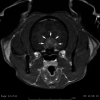Central diabetes insipidus in a cat with central nervous system B cell lymphoma
- PMID: 21906986
- PMCID: PMC7128173
- DOI: 10.1016/j.jfms.2011.07.005
Central diabetes insipidus in a cat with central nervous system B cell lymphoma
Abstract
A 6-year-old male neutered cat presented with blindness, lethargy, polydipsia, hyposthenuria and severe hypernatraemia. Central diabetes insipidus was demonstrated by means of a low measured anti-diuretic hormone (ADH) concentration in the face of hypernatraemia, and clinical response to supplementation with desmopressin. Magnetic resonance imaging of the brain showed a discrete mass in the region of the hypothalamus. The cat was euthanased and post-mortem histological examination demonstrated B cell lymphoma involving the brain, optic nerves, urinary bladder wall and diaphragm. To the authors' knowledge, this case report is the first to describe central diabetes insipidus caused by central nervous system lymphoma in the cat.
Copyright © 2011 ISFM and AAFP. All rights reserved.
Figures




Similar articles
-
Central diabetes insipidus associated with primary focal B cell lymphoma in a dog.Vet Rec. 2008 Jan 26;162(4):124-6. doi: 10.1136/vr.162.4.124. Vet Rec. 2008. PMID: 18223271 No abstract available.
-
Central diabetes insipidus in five cats: clinical presentation, diagnosis and oral desmopressin therapy.J Feline Med Surg. 2005 Dec;7(6):333-9. doi: 10.1016/j.jfms.2005.03.008. Epub 2005 May 31. J Feline Med Surg. 2005. PMID: 15927500 Free PMC article.
-
Hypernatremia associated with intracranial B-cell lymphoma in a cat.Vet Clin Pathol. 2006 Sep;35(3):362-5. doi: 10.1111/j.1939-165x.2006.tb00150.x. Vet Clin Pathol. 2006. PMID: 16967428
-
MRI of brain disease in veterinary patients part 2: Acquired brain disorders.Vet Clin North Am Small Anim Pract. 2010 Jan;40(1):39-63. doi: 10.1016/j.cvsm.2009.09.006. Vet Clin North Am Small Anim Pract. 2010. PMID: 19942056 Review.
-
Central diabetes insipidus in the setting of acute myelogenous leukemia.Am J Kidney Dis. 2012 Dec;60(6):998-1001. doi: 10.1053/j.ajkd.2012.07.024. Epub 2012 Oct 11. Am J Kidney Dis. 2012. PMID: 23062886 Review.
Cited by
-
Short-term severe polyuria responsive to vasopressin after hypoglycaemia and hypotension in a domestic shorthair cat.JFMS Open Rep. 2024 Nov 4;10(2):20551169241283294. doi: 10.1177/20551169241283294. eCollection 2024 Jul-Dec. JFMS Open Rep. 2024. PMID: 39502681 Free PMC article.
-
Primary central nervous system T-cell lymphoma mimicking meningoencephalomyelitis in a cat.Can Vet J. 2013 Jun;54(6):602-5. Can Vet J. 2013. PMID: 24155454 Free PMC article.
-
Neuropathology of Central and Peripheral Nervous System Lymphoma in Dogs and Cats: A Study of 92 Cases and Review of the Literature.Animals (Basel). 2023 Feb 27;13(5):862. doi: 10.3390/ani13050862. Animals (Basel). 2023. PMID: 36899719 Free PMC article.
-
Clinical and magnetic resonance imaging features of lymphoma involving the nervous system in cats.J Vet Intern Med. 2022 Mar;36(2):679-693. doi: 10.1111/jvim.16350. Epub 2022 Jan 20. J Vet Intern Med. 2022. PMID: 35048412 Free PMC article.
-
Aquaporin-2 regulation in health and disease.Vet Clin Pathol. 2012 Dec;41(4):455-70. doi: 10.1111/j.1939-165x.2012.00488.x. Epub 2012 Nov 6. Vet Clin Pathol. 2012. PMID: 23130944 Free PMC article. Review.
References
-
- Benitah N. Electrolyte disorders: sodium (hyper/hyponatremia). In: Ettinger SJ, ed. Textbook of veterinary internal medicine. St Louis: Elsevier Saunders, 2010: 299–301.
-
- Brown B. Evaluation of the plasma vasopressin, plasma sodium and urine osmolality response to water restriction in normal cats and a cat with diabetes insipidus. J Vet Int Med 1993; 7: 113.
-
- Nichols R. Clinical use of the vasopressin analogue DDAVP for the diagnosis and treatment of diabetes insipidus. Kirk's current veterinary therapy XIII: small animal practice. Oxford: Elsevier, 2000: 325–6.
-
- Hall JE. Urine concentration and dilution; regulation of extracellular fluid osmolarity and sodium concentration. Guyton and Hall textbook of medical physiology. 11th edn. Philadelphia: Elsevier Saunders, 2005: 358–60.
-
- McKinley MJ, Johnson AK. The physiological regulation of thirst and fluid intake. News Physiol Sci 2004; 19: 1–6. - PubMed
Publication types
MeSH terms
LinkOut - more resources
Full Text Sources
Miscellaneous

